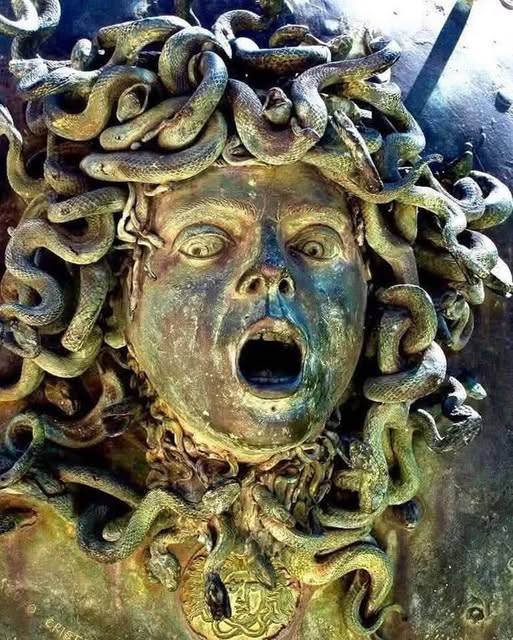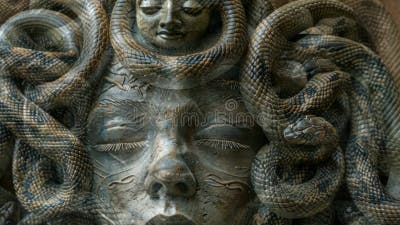The Bronze Head of Medusa: A Timeless Relic of Roman and Greek Heritage

Introduction to the Bronze Head of Medusa
The Bronze Head of Medusa, unearthed at Hadrian’s Villa in Tivoli, Italy, stands as a mesmerizing testament to the artistry and cultural interplay of the Roman Empire. This remarkable artifact, steeped in the lore of Greek mythology, captures the enigmatic figure of Medusa, one of the three Gorgons known for her serpent-laden hair and petrifying gaze. Discovered in a setting as grand as Hadrian’s Villa, a UNESCO World Heritage Site, the bronze sculpture not only showcases the technical prowess of ancient artisans but also underscores the enduring influence of Greek artistic traditions on Roman society. In this article, we will explore the historical, cultural, and artistic significance of the Bronze Head of Medusa, its mythological roots, and the architectural splendor of Hadrian’s Villa, delving into why this relic continues to captivate historians and art enthusiasts alike.

The Mythological Significance of Medusa
Who Was Medusa in Greek Mythology?
In Greek mythology, Medusa is one of the most iconic figures, renowned for her terrifying appearance and supernatural powers. As one of the three Gorgons—alongside her sisters Stheno and Euryale—Medusa was unique in her mortality, making her a target for heroes like Perseus. According to legend, Medusa’s hair was composed of writhing snakes, and her gaze could turn anyone who looked directly into her eyes to stone. This chilling ability made her both a feared and revered figure in ancient narratives.

Medusa’s story is multifaceted, blending themes of beauty, tragedy, and power. In some versions of the myth, Medusa was originally a beautiful maiden, cursed by Athena after a transgression in her temple. This transformation into a monstrous figure with serpentine locks and a deadly stare cemented her status as a symbol of both danger and protection. In ancient Greek art, Medusa was frequently depicted as a guardian figure, her fearsome visage used to ward off evil spirits and protect sacred spaces.
Medusa in Ancient Greek Art
The depiction of Medusa in ancient Greek art evolved over time, reflecting changing cultural perceptions. Early representations, such as those found on pottery from the Archaic period, often portrayed Medusa as grotesque, with bulging eyes, a protruding tongue, and a grimacing expression. These images emphasized her monstrous nature, aligning with her role as a fearsome deterrent.
By the Classical period, however, artists began to humanize Medusa, portraying her with softer features and a more tragic expression, hinting at her complex backstory. This shift is evident in sculptures and reliefs, where Medusa’s face often conveyed a haunting beauty, blending terror with melancholy. Her image adorned shields, temple pediments, and apotropaic amulets, reinforcing her role as a protective symbol against malevolent forces.

The Bronze Head of Medusa from Hadrian’s Villa likely draws from this tradition, blending Greek artistic motifs with Roman craftsmanship. Its discovery highlights how Greek mythology continued to resonate in Roman culture, serving both decorative and symbolic purposes.
The Bronze Head of Medusa: A Roman Masterpiece
Discovery at Hadrian’s Villa
The Bronze Head of Medusa was discovered at Hadrian’s Villa, a sprawling complex in Tivoli, Italy, built during the reign of Emperor Hadrian (117–138 CE). This luxurious retreat, located approximately 30 kilometers from Rome, served as a private residence for the emperor and a showcase of Roman architectural and artistic innovation. The villa’s discovery in the 15th century revealed a treasure trove of artifacts, including sculptures, mosaics, and architectural fragments, with the Bronze Head of Medusa being one of its most striking finds.

Crafted with remarkable precision, the bronze sculpture exemplifies the technical skill of Roman artisans. The intricate detailing of Medusa’s serpentine hair and the expressive rendering of her face demonstrate a mastery of bronze casting techniques. The sculpture likely served as a decorative element within the villa, possibly adorning a fountain, wall, or architectural feature, where it would have evoked both awe and reverence.
Artistic Features of the Sculpture
The Bronze Head of Medusa is a stunning example of Roman sculpture influenced by Greek prototypes. The serpents that form her hair are meticulously crafted, each one rendered with lifelike texture and movement, creating a sense of dynamism. The face of Medusa, with its intense expression, captures the duality of her mythological persona—both terrifying and captivating. The use of bronze, a durable and prestigious material, underscores the sculpture’s significance, as bronze was often reserved for high-status commissions in the Roman Empire.
The sculpture’s design also reflects the Roman penchant for blending functionality with aesthetics. As a decorative piece, it would have contributed to the opulent ambiance of Hadrian’s Villa, while its mythological subject matter added a layer of cultural and symbolic depth. The interplay of Greek and Roman artistic traditions is evident in the sculpture’s style, which combines the idealized forms of Greek art with the realism and grandeur characteristic of Roman portraiture.
Hadrian’s Villa: A UNESCO World Heritage Site
Historical Context of Hadrian’s Villa
Hadrian’s Villa, or Villa Adriana, is one of the most significant archaeological sites of the Roman Empire. Constructed in the early 2nd century CE, the villa was a sprawling complex that served as both a retreat for Emperor Hadrian and a display of imperial power. Covering over 120 hectares, the villa included palaces, temples, theaters, baths, and gardens, all designed with unparalleled architectural sophistication.
Hadrian, known for his love of Greek culture and architecture, incorporated elements inspired by his travels across the empire, particularly in Greece and Egypt. The villa’s design reflects this eclectic taste, with structures like the Canopus, a water feature inspired by an Egyptian sanctuary, and the Maritime Theater, a circular island retreat surrounded by a moat. The discovery of the Bronze Head of Medusa within this context underscores the villa’s role as a hub of cultural synthesis, where Greek mythology and Roman artistry converged.
Architectural and Cultural Significance
Recognized as a UNESCO World Heritage Site in 1999, Hadrian’s Villa is celebrated for its architectural innovation and historical importance. The complex is a testament to the wealth and ambition of the Roman Empire, showcasing advanced engineering techniques such as hydraulic systems, vaulted ceilings, and intricate mosaics. The villa’s layout, with its interconnected buildings and landscaped gardens, reflects the Roman ideal of harmony between architecture and nature.
The presence of artifacts like the Bronze Head of Medusa highlights the villa’s role as a center of artistic patronage. Hadrian, a cultured and erudite emperor, surrounded himself with works of art that reflected his appreciation for Greek aesthetics and mythology. The villa’s collection of sculptures, many of which were copies or adaptations of Greek originals, demonstrates the enduring influence of Hellenistic art on Roman culture.
The Influence of Greek Art on Roman Society
Cultural Exchange in the Roman Empire
The Roman Empire’s conquest of Greece in the 2nd century BCE marked the beginning of a profound cultural exchange that shaped Roman art and architecture. Greek mythology, literature, and artistic traditions were absorbed into Roman society, adapted to suit local tastes and imperial ideologies. Figures like Medusa, with their rich symbolic resonance, became popular motifs in Roman art, appearing in sculptures, mosaics, and frescoes.
The Bronze Head of Medusa is a prime example of this cultural synthesis. While the subject matter is rooted in Greek mythology, the craftsmanship and context of the sculpture are distinctly Roman. The Romans often reinterpreted Greek myths to align with their own values, using figures like Medusa to convey ideas of power, protection, and divine authority.
Medusa’s Role in Roman Art
In Roman art, Medusa’s image was versatile, serving both decorative and apotropaic functions. Her head, known as the Gorgoneion, was a common motif in architecture, appearing on shields, pediments, and household items like lamps and jewelry. The Romans believed that Medusa’s image could protect against evil, making it a popular choice for decorating public and private spaces.
The Bronze Head of Medusa from Hadrian’s Villa likely served a similar purpose, its fearsome yet beautiful visage designed to captivate and protect. The sculpture’s placement within the villa would have enhanced its symbolic power, aligning with the Roman practice of using art to convey status and divine favor.
The Enduring Legacy of the Bronze Head of Medusa
Why the Artifact Matters Today
The Bronze Head of Medusa remains a powerful symbol of the cultural and artistic legacy of the Roman Empire. Its discovery at Hadrian’s Villa offers a glimpse into the sophistication of Roman art and the enduring appeal of Greek mythology. As a UNESCO World Heritage Site, Hadrian’s Villa continues to attract scholars, tourists, and art enthusiasts, who are drawn to its architectural grandeur and the stories told by artifacts like the Medusa sculpture.
The artifact also highlights the timeless nature of Medusa’s myth. Her image, with its blend of beauty and terror, continues to inspire modern artists, writers, and filmmakers. From Renaissance paintings to contemporary pop culture, Medusa’s legacy endures, reflecting humanity’s fascination with the interplay of power, fear, and beauty.
Preservation and Study
Today, the Bronze Head of Medusa is a valuable resource for archaeologists and historians studying the Roman Empire. Its preservation allows researchers to analyze the techniques used in ancient bronze casting and the cultural significance of mythological motifs. The sculpture also provides insight into Hadrian’s personal tastes and the role of art in imperial propaganda.
Museums and institutions dedicated to classical art often showcase similar artifacts, offering the public a chance to engage with the rich history of the Greco-Roman world. The Bronze Head of Medusa, with its intricate craftsmanship and mythological resonance, serves as a bridge between past and present, inviting us to explore the stories and values of ancient civilizations.
Conclusion
The Bronze Head of Medusa, discovered at Hadrian’s Villa, is more than just a beautiful artifact; it is a window into the cultural, artistic, and historical dynamics of the Roman Empire. Rooted in Greek mythology, the sculpture reflects the enduring influence of Hellenistic traditions on Roman society, while its discovery at a UNESCO World Heritage Site underscores the architectural and cultural significance of Hadrian’s Villa. By examining this remarkable relic, we gain a deeper understanding of the artistry, mythology, and imperial ambition that defined the ancient world. The Bronze Head of Medusa continues to captivate and inspire, reminding us of the timeless power of art to tell stories and connect us to our shared human heritage.